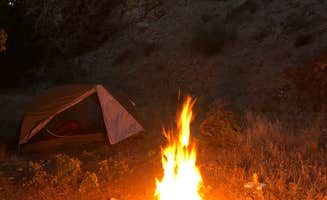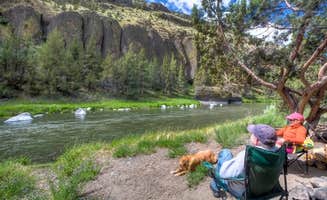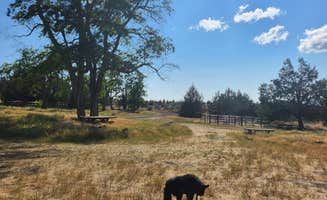Dispersed camping areas near Mitchell, Oregon, lie within the high desert of central Oregon at elevations ranging from 2,000 to 5,000 feet. Temperatures can vary significantly between day and night, with summer days often exceeding 90°F while dropping to the 40s overnight. Most sites require visitors to travel on unpaved roads that can become impassable when wet, especially during spring months or after thunderstorms.
What to do
Stargazing after sunset: The area around Crooked River National Grasslands offers exceptional night sky viewing with minimal light pollution. "The stars are amazing the moon was playing peekaboo all night and the colors of the sky were spectacular sites to see," noted one visitor at Jasper Point, while another camper at Crooked River mentioned "incredible stars, super peaceful."
Swimming in the John Day River: During hot summer days, the Priest Hole Recreation Area provides access to cooling water. "The river is gorgeous and perfect for swimming," reports one camper. Another notes that "when the river is lower you can camp in any of the rocky dry stream beds and be safely right on the water."
Hiking short trails: Use your camp as a base for exploring nearby trails. One camper at Green Mountain North Trailhead shared, "We walked up the hill and enjoyed the birds and saw some lizards. Very peaceful spot." Most trails in the area are moderate in difficulty and range from 0.5 to 3 miles in length.
What campers like
Solitude and quiet: Many visitors appreciate the peaceful atmosphere at Jasper Point Dispersed camping areas. "So quiet that you can hear a pin drop," reports one camper. Another mentioned, "We were rewarded with a lovely sunset over the Cascade mountains the night before. Not heavily used so very clean."
Geology exploration: The unique terrain draws campers interested in geological features. A visitor at Painted Hills Dispersed mentioned, "I appreciated the beauty of the painted hills around us... I liked all the signs on the painted cove trail explaining the geological history of the area."
Weather variety: The climate creates diverse conditions that appeal to experienced campers. "The weather here is moody," wrote one visitor. "We suddenly had lightning all around us, followed by the sky dumping rain the next morning for hours practically creating a river. Then as soon as it was done it dried up basically like nothing happened."
What you should know
Road conditions: Access to many free camping spots near Mitchell requires careful driving. One visitor to Little Hay Creek Rd Dispersed advised, "A little bumpy ride for regular cars as it is in a dirt road; an AWD preferred." Another camper noted, "the roads were too pot holed and rough for us in our 26ft class c."
Site preparation: Bring leveling blocks and prepare for rocky terrain. "It's rocky AF," warned one camper. Another mentioned, "There aren't many places for tents because of rocks, we were able to hammock no problem."
Limited services: No amenities exist at most sites. "Of course no services, so pack out what you bring in," reminded one visitor. Campers must bring all water needed for their stay as no reliable natural sources exist at most locations.
Wildlife encounters: Prepare for unexpected animal visitors. One camper shared a surprising experience: "The next morning we found ourselves eye to eye with some rather large friends grazing 😂...the sign seemed a little off at first and the fence is certainly a DIY build so we were a little confused."
Tips for camping with families
Safety near water: When camping with children at river sites, choose locations where water access is gradual. "The water was the perfect temperature for swimming and crystal clear," noted a visitor to Priest Hole Recreation Area, though parents should always supervise children near water.
Insect preparation: Bring insect repellent, especially for evening hours. One camper mentioned, "quite a few earwigs and other bugs attacking the outside tent at night when we had our light on. Not the worst thing, but slightly annoying for the kiddos."
Shade considerations: Many sites offer limited natural shade. "It gets a little windy and not too much shade during the day," warned a visitor at Painted Hills South Camp. Consider bringing pop-up shade structures during summer months when temperatures frequently exceed 90°F.
Educational opportunities: Use informational signs at nearby landmarks for learning moments. A camper noted appreciating "all the signs on the painted cove trail explaining the geological history of the area. BLM camping i.e. free."
Tips from RVers
Site selection for larger vehicles: For RVs over 20 feet, choose sites carefully. "There are many spots down the road once you pass the bridge here, but the roads were too pot holed and rough for us in our 26ft class c," cautioned one RVer.
Maneuvering challenges: Recent improvements at some sites have created new considerations. "The road to the river sites is NARROW, and we had trouble backing in with a 22' trailer while not hitting the guard rail, but the pull through sites are a lot farther from the river," explained a visitor to Priest Hole.
Level parking: Larger rigs need level spots, which can be limited. "We were able to level up and had no neighbors until the morning of the eclipse when several people and RVs came in," shared one RVer at Gable Creek Road Dispersed Camping, noting "the site can accommodate a pretty big rig or trailer, although there's really only one fairly level area."
Road hazards: Drive slowly and scout ahead when possible. "Bottomed out a few times," warned one driver in a minivan, while another mentioned, "I wouldn't trust the road in the rain, it looks like it turns into a mud pit."







